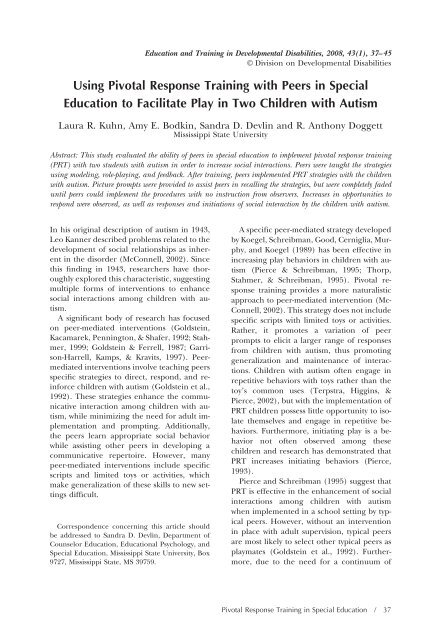Download the Journal (PDF) - Division on Autism and ...
Download the Journal (PDF) - Division on Autism and ...
Download the Journal (PDF) - Division on Autism and ...
You also want an ePaper? Increase the reach of your titles
YUMPU automatically turns print PDFs into web optimized ePapers that Google loves.
Using Pivotal Resp<strong>on</strong>se Training with Peers in Special<br />
Educati<strong>on</strong> to Facilitate Play in Two Children with <strong>Autism</strong><br />
Laura R. Kuhn, Amy E. Bodkin, S<strong>and</strong>ra D. Devlin <strong>and</strong> R. Anth<strong>on</strong>y Doggett<br />
Mississippi State University<br />
Abstract: This study evaluated <str<strong>on</strong>g>the</str<strong>on</strong>g> ability of peers in special educati<strong>on</strong> to implement pivotal resp<strong>on</strong>se training<br />
(PRT) with two students with autism in order to increase social interacti<strong>on</strong>s. Peers were taught <str<strong>on</strong>g>the</str<strong>on</strong>g> strategies<br />
using modeling, role-playing, <strong>and</strong> feedback. After training, peers implemented PRT strategies with <str<strong>on</strong>g>the</str<strong>on</strong>g> children<br />
with autism. Picture prompts were provided to assist peers in recalling <str<strong>on</strong>g>the</str<strong>on</strong>g> strategies, but were completely faded<br />
until peers could implement <str<strong>on</strong>g>the</str<strong>on</strong>g> procedures with no instructi<strong>on</strong> from observers. Increases in opportunities to<br />
resp<strong>on</strong>d were observed, as well as resp<strong>on</strong>ses <strong>and</strong> initiati<strong>on</strong>s of social interacti<strong>on</strong> by <str<strong>on</strong>g>the</str<strong>on</strong>g> children with autism.<br />
In his original descripti<strong>on</strong> of autism in 1943,<br />
Leo Kanner described problems related to <str<strong>on</strong>g>the</str<strong>on</strong>g><br />
development of social relati<strong>on</strong>ships as inherent<br />
in <str<strong>on</strong>g>the</str<strong>on</strong>g> disorder (McC<strong>on</strong>nell, 2002). Since<br />
this finding in 1943, researchers have thoroughly<br />
explored this characteristic, suggesting<br />
multiple forms of interventi<strong>on</strong>s to enhance<br />
social interacti<strong>on</strong>s am<strong>on</strong>g children with autism.<br />
A significant body of research has focused<br />
<strong>on</strong> peer-mediated interventi<strong>on</strong>s (Goldstein,<br />
Kacamarek, Penningt<strong>on</strong>, & Shafer, 1992; Stahmer,<br />
1999; Goldstein & Ferrell, 1987; Garris<strong>on</strong>-Harrell,<br />
Kamps, & Kravits, 1997). Peermediated<br />
interventi<strong>on</strong>s involve teaching peers<br />
specific strategies to direct, resp<strong>on</strong>d, <strong>and</strong> reinforce<br />
children with autism (Goldstein et al.,<br />
1992). These strategies enhance <str<strong>on</strong>g>the</str<strong>on</strong>g> communicative<br />
interacti<strong>on</strong> am<strong>on</strong>g children with autism,<br />
while minimizing <str<strong>on</strong>g>the</str<strong>on</strong>g> need for adult implementati<strong>on</strong><br />
<strong>and</strong> prompting. Additi<strong>on</strong>ally,<br />
<str<strong>on</strong>g>the</str<strong>on</strong>g> peers learn appropriate social behavior<br />
while assisting o<str<strong>on</strong>g>the</str<strong>on</strong>g>r peers in developing a<br />
communicative repertoire. However, many<br />
peer-mediated interventi<strong>on</strong>s include specific<br />
scripts <strong>and</strong> limited toys or activities, which<br />
make generalizati<strong>on</strong> of <str<strong>on</strong>g>the</str<strong>on</strong>g>se skills to new settings<br />
difficult.<br />
Corresp<strong>on</strong>dence c<strong>on</strong>cerning this article should<br />
be addressed to S<strong>and</strong>ra D. Devlin, Department of<br />
Counselor Educati<strong>on</strong>, Educati<strong>on</strong>al Psychology, <strong>and</strong><br />
Special Educati<strong>on</strong>, Mississippi State University, Box<br />
9727, Mississippi State, MS 39759.<br />
Educati<strong>on</strong> <strong>and</strong> Training in Developmental Disabilities, 2008, 43(1), 37–45<br />
© <str<strong>on</strong>g>Divisi<strong>on</strong></str<strong>on</strong>g> <strong>on</strong> Developmental Disabilities<br />
A specific peer-mediated strategy developed<br />
by Koegel, Schreibman, Good, Cerniglia, Murphy,<br />
<strong>and</strong> Koegel (1989) has been effective in<br />
increasing play behaviors in children with autism<br />
(Pierce & Schreibman, 1995; Thorp,<br />
Stahmer, & Schreibman, 1995). Pivotal resp<strong>on</strong>se<br />
training provides a more naturalistic<br />
approach to peer-mediated interventi<strong>on</strong> (Mc-<br />
C<strong>on</strong>nell, 2002). This strategy does not include<br />
specific scripts with limited toys or activities.<br />
Ra<str<strong>on</strong>g>the</str<strong>on</strong>g>r, it promotes a variati<strong>on</strong> of peer<br />
prompts to elicit a larger range of resp<strong>on</strong>ses<br />
from children with autism, thus promoting<br />
generalizati<strong>on</strong> <strong>and</strong> maintenance of interacti<strong>on</strong>s.<br />
Children with autism often engage in<br />
repetitive behaviors with toys ra<str<strong>on</strong>g>the</str<strong>on</strong>g>r than <str<strong>on</strong>g>the</str<strong>on</strong>g><br />
toy’s comm<strong>on</strong> uses (Terpstra, Higgins, &<br />
Pierce, 2002), but with <str<strong>on</strong>g>the</str<strong>on</strong>g> implementati<strong>on</strong> of<br />
PRT children possess little opportunity to isolate<br />
<str<strong>on</strong>g>the</str<strong>on</strong>g>mselves <strong>and</strong> engage in repetitive behaviors.<br />
Fur<str<strong>on</strong>g>the</str<strong>on</strong>g>rmore, initiating play is a behavior<br />
not often observed am<strong>on</strong>g <str<strong>on</strong>g>the</str<strong>on</strong>g>se<br />
children <strong>and</strong> research has dem<strong>on</strong>strated that<br />
PRT increases initiating behaviors (Pierce,<br />
1993).<br />
Pierce <strong>and</strong> Schreibman (1995) suggest that<br />
PRT is effective in <str<strong>on</strong>g>the</str<strong>on</strong>g> enhancement of social<br />
interacti<strong>on</strong>s am<strong>on</strong>g children with autism<br />
when implemented in a school setting by typical<br />
peers. However, without an interventi<strong>on</strong><br />
in place with adult supervisi<strong>on</strong>, typical peers<br />
are most likely to select o<str<strong>on</strong>g>the</str<strong>on</strong>g>r typical peers as<br />
playmates (Goldstein et al., 1992). Fur<str<strong>on</strong>g>the</str<strong>on</strong>g>rmore,<br />
due to <str<strong>on</strong>g>the</str<strong>on</strong>g> need for a c<strong>on</strong>tinuum of<br />
Pivotal Resp<strong>on</strong>se Training in Special Educati<strong>on</strong> / 37
















